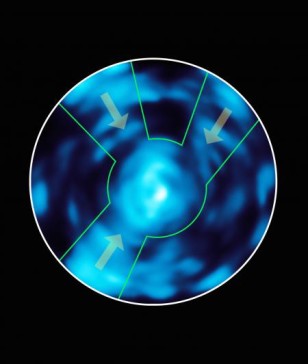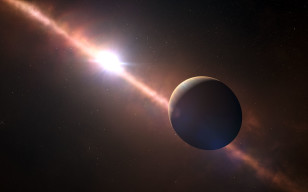
Lyman alpha blob in emerging galaxy cluster SSA22 imaged with Caltech’s Cosmic Web Imager. The arrows show the gas filaments of the IGM flowing into blob. (Christopher Martin, Robert Hurt)
For the first time, 3D images have been captured of a cosmological entity called the intergalactic medium (IGM). Until now, the structure of IGM had been theoretical.
The discovery could provide astronomers with a new understanding of galactic and intergalactic dynamics.
The images were captured with an instrument built at the California Institute of Technology called the Cosmic Web Imager. The device was installed on the Hale 200-inch telescope at Palomar Observatory near San Diego, California.
IGM is a network or web of thread-like formations of diffuse gases left over from the Big Bang that links all the galaxies in the universe together.
Christopher Martin, professor of physics at Caltech, created and developed the device.
“I’ve been thinking about the intergalactic medium since I was a graduate student,” he said. “Not only does it comprise most of the normal matter in the universe, it is also the medium in which galaxies form and grow.”
The first intergalactic filaments of IGM imaged by Martin’s team were within an area of space occupied by a quasar and something known as a Lyman alpha blob – considered to be one of the largest objects in the universe – which was found within a developing galaxy cluster.

Caltech’s Cosmic Web Imager installed in the Cassegrain cage of the Hale 200 inch telescope at Palomar Observatory. (Matt Matuszewski)
Martin and his colleagues observed one narrow filament that flowed into the quasar. The astronomers determined that it was about one million light-years long and might be powering the growth of the galaxy that contains the quasar. The team also found three filaments surrounding the Lyman alpha blob. Measurements indicated the diffuse gas from the filaments was pouring into the blob and affecting its dynamics.
The scientists associated with the Cosmic Web Imager say the device has already spotted one possible spiral-galaxy, three times the size of our Milky Way galaxy, that is still developing.
Planet Outside Solar System Spins Itself Into 8-hour Days

Artist rendering of Beta Pictoris b orbiting its star. The exoplanet is the first to have its rotation rate measured. (ESO, L. Calçada/N. Risinger)
For the first time, astronomers have been able to measure the rotational speed of an exoplanet.
They found that a day on Beta Pictoris b, a young planet discovered about six years ago, is just eight hours long.
A team of astronomers from Leiden University in the Netherlands used the European Southern Observatory’s Very Large Telescope to make the measurement.
The team found that the planet, which is more than 16 times larger and has 3,000 times the mass of Earth, orbits its sun at a speed of about 100,000 km per hour at its equator.
Compare that to Earth, which rotates at an equatorial velocity of 1,700 km per hour, resulting in 24-hour days.

An annotated view of the Beta Pictoris system, including planet Beta Pictoris b as imaged in 2008 with special equipment mounted on ESO’s Very Large Telescope (ESO via Creative Commons)
“It is not known why some planets spin fast and others more slowly,” says Remco de Kok, co-author of a paper outlining the discovery. “But this first measurement of an exoplanet’s rotation shows that the trend seen in the Solar System, where the more massive planets spin faster, also holds true for exoplanets. This must be some universal consequence of the way planets form.”
Beta Pictoris b orbits Beta Pictoris, a star visible to the naked eye, which is about 63 light-years from Earth. The star and its planet are within the southern constellation of Pictor, which means “the painter’s easel” in Latin.
Beta Pictoris b was also one of the first exoplanets to be directly imaged. Orbiting its star at a distance of about 1,196,782,968 km or 8 times the distance of the Earth from the Sun, it’s also the closest extrasolar planet to its star to be directly imaged.





















Lunar month, solar year, and the Galactic year—Last galactic year it was the dinosaurs, this galactic year is the turn of present living creatures to be extinct!
Just as we have a lunar month corresponding to one revolution of the moon about our planet (28days), and a solar year corresponding to one revolution of our planet about the sun (365days), so also we must have a galactic year corresponding to one revolution of our solar system about the center of our Milky Way galaxy. This occurs about once every 200 million years. Significantly, the solar year carries with it seasonal changes that affect the planets and that are critical to the survival of plant and animal life. So also, logic would appear to suggest, the galactic year should portend long-term seasonal changes that must define the fate of stars and planets in the Milky Way galaxy. This even becomes more of a characteristic of nature if we consider that the revolution of the moon once in about 28 days may not be unconnected with the menstrual cycle of females, although the sun also rotates about its axis roughly once every four weeks (28 days, evident from observation of sunspots). While we do not need any persuasion to believe that no living thing has a life span of close to a million years, let alone 200 million years, we would still want to know what seasonal cycle repeats every 200 million years (Galactic year) for the planets and the stars of our galaxy, considering that our sun has a lifespan of well over 6 billion years. Keep in mind that there are only five sets of 200 million in a billion.
We recall that the dinosaurs became extinct about 200 million years ago. With the end of another galactic year, i.e. 200 million year era, fast approaching, whose turn will it be next to be extinct we may dare to ask? We are of course wildly conjecturing that extinction of living creatures is nature’s weird way of celebrating the end of every 200 million years, the dinosaurs being the dominant living creatures during their time. The signs are ominous! Going by the Radiation Intensity Peak Movement just analyzed above vis-à-vis climate change currently mostly attributed to greenhouse effect, all indications are that it will be the turn of all current living creatures this time. And this, without sounding unnecessarily alarmist, should include the current dominant living creatures, man and indeed all animal species! Alternatively, going by the self-destruct nature of our recent scientific discoveries in the area of weaponry, nuclear or otherwise, as well as the level of hate mongering consuming humanity, living creatures may not be privileged to revisit the end of the galactic year before bringing an end to all life forms! The dinosaurs derived that rare privilege by not being blessed with a superior intellect and scientific skills. They could not therefore parade themselves as mindless arrogant super achievers who cared very little about destroying an entire all inclusive breed of living creatures, something even the primitive, terrifying dinosaurs would consider irrational and stupid.
——-Taken from the book Radiation Intensity Peak Movement and Climate Change by Emmanuel Ebube